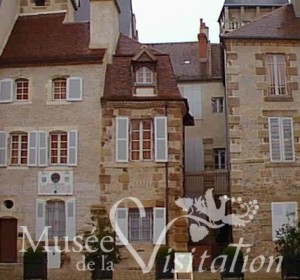 The French press continues to cover the current exhibit in the Museum of the Visitation: http://www.famillechretienne.fr/culture-loisirs/sorties/les-visitandines-entre-faste-et-humilite-178406
The French press continues to cover the current exhibit in the Museum of the Visitation: http://www.famillechretienne.fr/culture-loisirs/sorties/les-visitandines-entre-faste-et-humilite-178406
Approximate translation:
The Visitation, between ostentation and humility
By Bertille Perrin
The museum of the Visitation in Moulins offers a magnificent exhibition of liturgical objects and archival documents. The history of four hundred years of religious life in Bourbonnais.
The Visitation museum has set 2500 pieces of textiles, including more than 300 liturgical vestments.
And more than 500 gold and silver coins are exhibited ,nearly 1000 devotional objects and paintings, painted images and several master paintings.
In the Visitation, nothing is too good for Christ. Careful fabricated rolled paper, chasubles embroidered with fine gold, chalices inlaid with precious stones or oversized reliquaries: faced with such a heritage, one can not help feeling that as regards beauty of the liturgy, the best hours of creation appear to be in the past.
This treasure, complete with objects from different Visitations of France and the world, is now preserved in Moulins in Allier, just a few meters from the Monastery Sainte-Marie, whose history has marked that of the the entire Visitation Order. It is this unusual history that the museum wanted to trace in a temporary exhibition : we discover how the little house of religious in Moulins had become one of the liveliest monasteries of France.
Founded in 1616, the monastery received its reputation and vitality from many influential personalities, who helped to develop it materially and spiritually. The successive visits of St. Jane de Chantal, co-founder of the order with St. Francis de Sales, marked the Sisters. The future saint even died there in 1641, and Moulins became a place of pilgrimage. Her room is transformed into an oratory, and her heart revered in a beautiful silver reliquary.
Many benefactors
Maria Felice Orsini, widow of the Duke of Montmorency,wa s a rich benefactor with a strong taste for the beautiful. In 1650, she built a church for the Sisters with a single liturgical treasure. The Duchess, who greatly admired Jeanne de Chantal, decided in 1657 to abandon her wealth to enter religion. She became Sister Marie-Henriette, and offered some of her assets to the community and led the simple and retired life of the Visitandines. But the world had not forgotten her . One day, King Louis XIV himself made visit to the enclosure and exclaimed visiting her cell: “Is it possible that ten feet of space makes today’s house of Madame de Montmorency! “If some precious stones inlaid in the liturgical objects demonstrate the benefits of the Duchess for the Order, the exhibition also reflects the poor and deprived life of Sister Marie-Henriette.
Other women entered the monastery in the following years, as the granddaughter of Nicolas Fouquet, Superintendent of Finance at the time of Mazarin. Le Fouquet Marshal Belle-Isle, brother of the new religious, became one of the main sponsors of the Visitation of Moulins: he offered new bells in cast iron. We can measure the abundance of generosity contemplating the imposing and colorful shrine in chinoisant style.
For the greater glory of God
But treasure of the Visitation was not only from donations from families and benefactors. The religious themselves put their talents at the service of Christ and made true works of art. The paintings, embroideries and paintings in rolled papers that adorn the walls and the exhibition showcases masterly reflect the care and thoroughness of the nuns, who put their heart into it … to the greater glory of God. “No work of the Sisters is signed, it would be absurd, as humility is at the heart of the spirit of the Visitation,” said Jean Foisselon, deputy director of the museum.
If beauty and quality of works held today testify to a flourishing past, the heritage of the Visitation of Moulins, however, suffered considerably from the vagaries of history. If one believes the revolutionary inventories, the equivalent of one hundred and seventy kilograms of silver was confiscated during the Revolution, and hundreds of precious stones. But having anticipated their forced exile, the sisters managed to save the beautiful sets of jewelry honored today.
It was only in 1876 at the call of Bishop Pierre-Simon de Dreux-Breze, that the Visitation rebuilt a new monastery in the capital of Bourbonnais, the old building having become the first school in France. The monastery came back to life and gradually regained its dynamism. It still houses a dozen Sisters, perpetuating four hundred years of monastic life at the school of their founding saints.
“Religious are never more content than when they are all alone to contemplate the beauty of the heavenly Lover at ease,” said St. Francis de Sales (Sermon 25 March 1621). By examining the history of the Moulins Visitation, and admiring the wonders of the Museum of the Visitation, it is understandable that, to welcome the “Lover of heavenly beauty,” the nuns could only adorn the altar by wearing their beautiful habits.
Bertille Perrin
• “We Visitation of Moulins”, 83, rue d’Allier in Moulins. Until December 24. From Tuesday to Saturday from 10 am to 12 pm and from 14 am to 18 pm. Sundays and holidays from 15 am to 18 pm.
• Permanent collections: 4, instead of the Old Palace. Temporary and permanent exhibitions: € 7, temporary exhibition only: € 4. 04 70 44 39 03; www.musee-visitation.eu